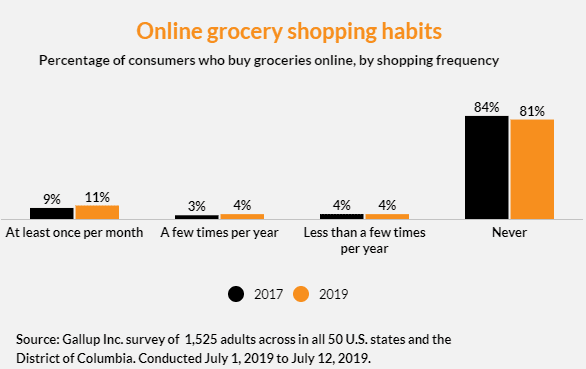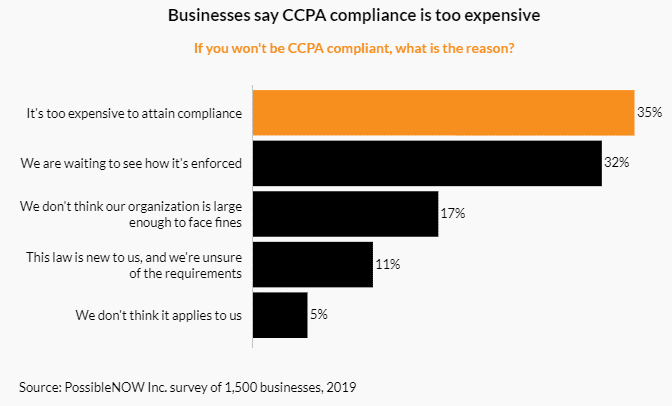Online Grocery Shoppers Remain a Minority

In 2019, just 11.0% of consumers said they go online grocery shopping at least once per month including pick-up and delivery. This stat is up from 9.0% in 2017 showing just 2% growth across 2 years. 4.0% of consumers say they go online grocery shopping at least once per week, which was unchanged from 2017.
Why is online grocery shopping seeing such slow growth? There are many barriers to entry concerning the outsourcing of personal grocery shopping. The first being the nature of grocery in general.
When it comes to tasks like examining individual cuts of meat or picking out produce items, many shoppers don’t trust a strangers eye to know what they’re looking for or have their best interest in mind. Additionally, while some may view grocery shopping as a chore, others see it as a calming, sensory experience or even a social time.
Another unsurprising barrier to online grocery shopping is the service or delivery charges involved. Some retailers are dealing with that by waiving fees for the initial three purchases, or providing free delivery or pickup services above certain dollar thresholds.
Millennials and Gen Z Looking for More From Fashion Brands

Generations Z and Y (aka millennials) constitute an ever-increasing force in the global economy’s spending power. This is causing a huge shift in retail fashion spending. While Gen X and baby boomers grew up in a consumerist culture, Generations Y and Z seek long-lasting, high-quality products instead of disposable items. In addition to looking at higher quality products, they want to know where their products are made, by whom, and with what materials. Before making a purchase, they consider a product’s ecological footprint and full lifecycle, from design to production and shipping.
Specifically in the clothing space, “fast fashion” isn’t as appealing to younger generations as sustainable, eco-friendly apparel. Gen Z and millennials define and evaluate brands on the basis of both product and ethics. They not only expect their favorite brands to represent their beliefs and values, but to be authentic and transparent.
The implications and risks for companies who opt out of being eco-friendly and sustainable are significant. Brands may face boycotts and social media wrath if they are deceptive or inauthentic, or if human rights or environmental violations are revealed by the media or consumers.
California Consumer Privacy Act Demands Expensive Changes

The California Consumer Privacy Act, which will go into effect January 1, 2020, gives Californians rights to opt out of the sale of their personal information, the ability to have their data deleted and a right to know what has been collected on them.
This impacts every online retailer that sells to California consumers, as most merchants collect a consumer’s name, location, IP addresses and identifiers that track their web and app use on their internet-connected devices, such as laptops and smartphones.
Of surveyed businesses, only 8% of businesses are prepared for this change. While some businesses are waiting to see how/if the law will be enforced, others claim it is simply too expensive to make the necessary changes to comply.
While the California Consumer Privacy Act in particular just affects Californian consumers, businesses hoping to avoid the changes may just be delaying the inevitable as many other states are proposing similar requirements.
Home Depot Dominates Lowe’s in Q2 Ecommerce Growth

The Home Depot reported a 20% year-over-year increase in online sales, while Lowe’s reported a 4% increase. Lowe’s made fundamental changes in their stock and inventory processes that they predicted would slow their growth during Q2.
While these changes had larger effects than they had predicted, they confirm that these changes were essential to future profitability. The old system required bricks-and-mortar stores to add products to inventory before they could be added online, which was not sustainable for ecommerce growth. With the new system, Lowe’s is adding more products to its online selection as it moves low-volume SKUs out of its stores.
Upon reflection, it was vital to modernize its inventory systems and throughout the rest of the year, Lowe’s will work on other “foundational functionality” like search, checkout and navigation improvements.
Looking for more industry insights? Check out our latest installments:



